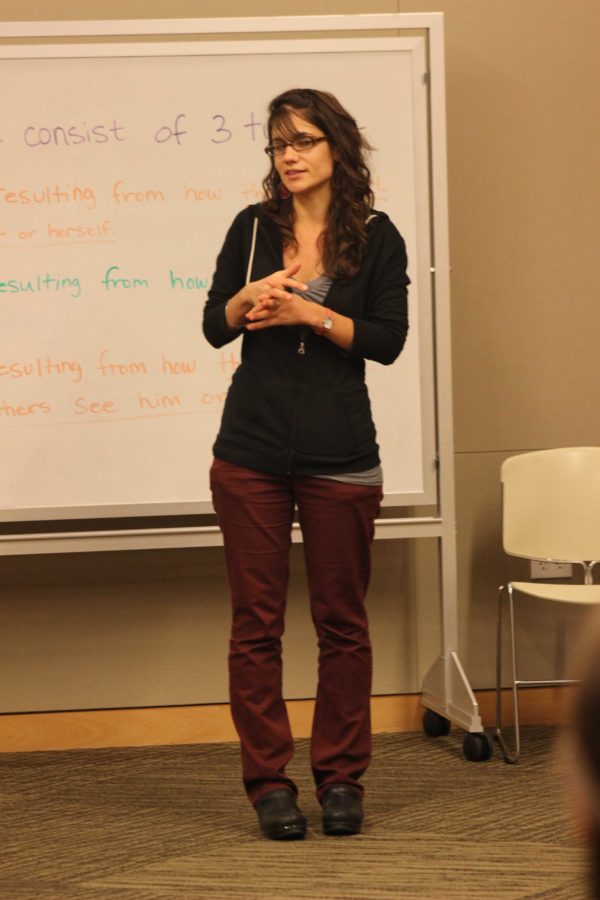Self-image is how people see themselves. Self-image also results from how others see those people and how people perceive the way others see themselves. Facing various issues of self-image during its workshop “Mirror, Mirror – Reflecting on Positive Self Image,” the SRJC People Empowering Each other to Realize Success coalition examined reasons behind negative self-image and the steps towards a positive one Nov. 7 in the Bertolini Student Center.
“This is by far the biggest turnout we have ever had,” said SRJC student Cheri McLean. As a PEERS member, she greeted the chatty group of predominantly young women occupying every seat and floor space available; among them were nursing majors, psychology majors and the entire women’s soccer team.
Guest speakers Ayano Healy and Nora Bulloch from the Northern California Center for Well-Being presented ideas about positive self-imagery, action plans and positive self-talk. Bulloch, a registered dietician-nutritionist, came upon positive self-image while counseling patients on weight control. She explains to patients that being healthy is not simply taking pills and going about your day; being healthy is about changing your habits.
Bulloch explained that our minds require a change of habit as well. Self-talk, which refers to the private conversation in our heads, can be extremely damaging to one’s self-esteem when negative thoughts take over.
“What’s hard with behavior change and self-image is that you have to stop and listen and ask yourself, ‘What are you saying to yourself?’” Bulloch said.
When an individual feels bad, this indicates negative self-talk. It is the “disadvantage that is the advantage,” the trigger telling an individual that something needs to change.
“People should try to change the negative things they said to themselves into positive ones for the reason that if you don’t love yourself, you can’t love anybody else,” SRJC student Anna Lucas said.
Many shared their insight during an exercise in which participants were asked to explore their negative self-talk. One audience member said, “I always wished that I was smarter. I am dumb.” Another said, “I beat myself up and this inhibits me from moving forward.” Others shared: I am ugly, and I am not good enough.
The negative statements were then turned into positive ones by Bulloch and Healy. “I am smart. I am learning. I am beautiful and I am worthy.” As a tip, Bulloch suggests using only positive words when creating positive self-talk. Never say, “I am not dumb, always say ‘I am smart.” Bulloch also says to use adverbs; say “I am happily learning.”
The five steps towards positive change include writing down those self-defeating thoughts, changing them to more rational and helpful thoughts, rehearsing, practicing and being patient. Bulloch expressed the importance of patience.
“I am a big believer in the sticky note,” Bulloch said, suggesting that her audience members write positive sayings on them and place the sticky notes on mirrors and around the house, anywhere they would be seen daily.
Healy then presented the Center for Well-Being’s action plan. First, it must be something that you want to do, “not your therapist, not your friend; you,” Healy said. Next, make sure the goal is attainable, then answer the following questions: “what, how much, when, how often.” Last, assess your confidence level on a scale of 0 to 10. “Your gut check should be around a seven,” Healy said. If it is lower, see what needs to be changed.
The action plan is structured for one-week intervals. “The most important thing with this Action Plan is to see it as a tool and as a routine, see what you want and break it down into a process,” Healy said.
SRJC students shared their action plans varying from wanting to become a faster runner to taking time out each week for some ‘me time.’
“By accomplishing this simple action plan and simple steps, this raises your self-esteem,” Bulloch said.
Encouraging her audience to take goals one week at a time, Healy said, “We have to be patient, look at yourself and validate the success you are making this week.”
Combining positive self-image and the action plan Healy and Bulloch led a final activity where participants wrote down positive self-attributes on paper representing a mirror. Many were pleased with the results, commenting, “I ran out of space,” and “It felt good, sometimes you only say negative things and it’s nice to stay positive.”
Becky Fein, coordinator of PEERS coalition, shared a haunting video of a model being completely transformed by Photoshop. Creating an entirely new person, the footage shined a spotlight on media as a culprit in many individuals’ insecurities.
“Images in mass media represent less than 3 percent of the population,” Fein said.
Sharing her personal story of seeing Heidi Klum on an airplane, and noting how she “was pretty but not the drop-dead gorgeous woman you see on the magazines,” a participant supported this idea.
“We all exhibit a different form of beauty,” McLean said.


